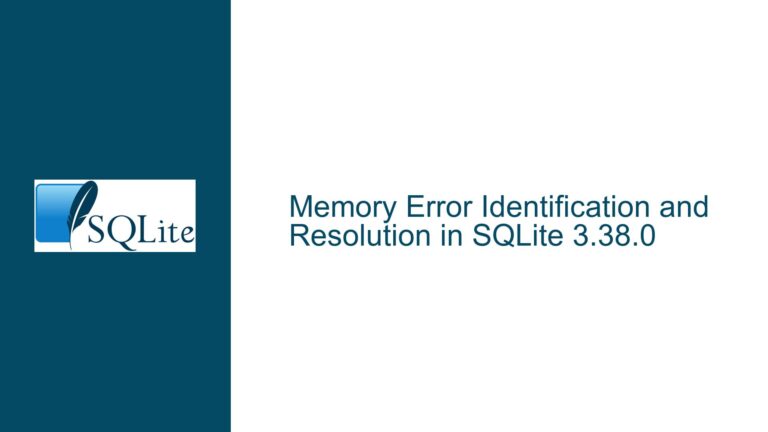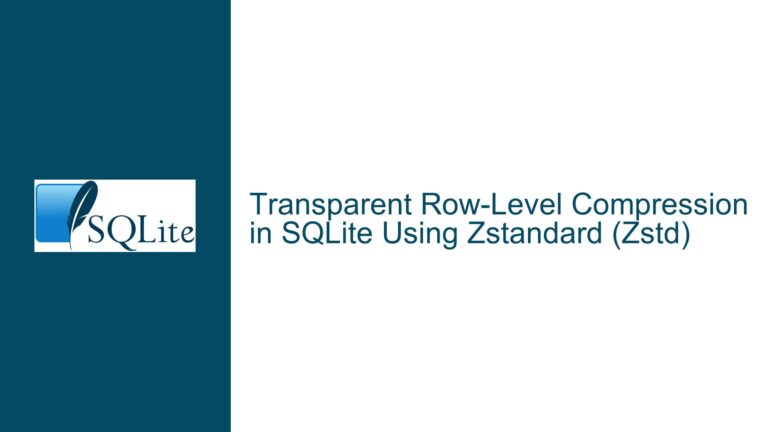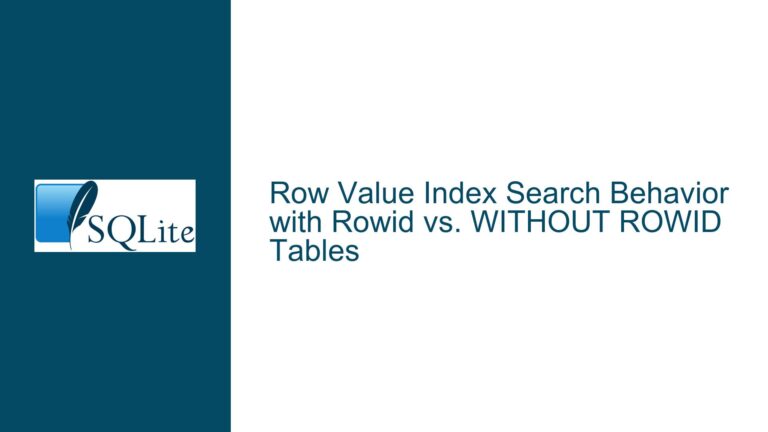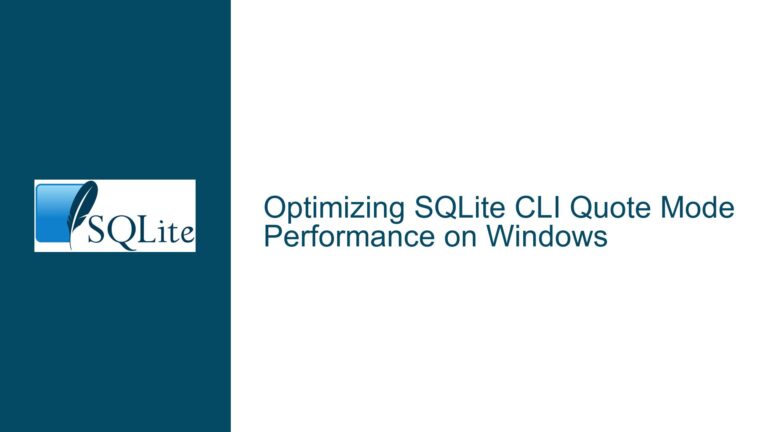Efficiently Sharing Aggregate State Across Multiple SQLite Functions
Understanding the Challenge of Shared Context in Multi-Aggregate Queries
When working with SQLite, developers often encounter scenarios where multiple aggregate functions need to operate on the same dataset. A common example involves calculating regression parameters such as slope, intercept, and coefficient of determination (R²) from a single dataset. The naive approach—invoking separate aggregates like REGR_SLOPE(y,x), REGR_INTERCEPT(y,x), and REGR_R2(y,x)—leads to redundant computation. Each function independently processes the dataset, recalculating intermediate values (e.g., sums, means, covariance) that could otherwise be shared. This redundancy wastes computational resources and increases query execution time.
The core challenge lies in SQLite’s architecture for aggregate functions. Each aggregate operates in isolation, maintaining its own internal state during the xStep (accumulation) phase and producing a result during xFinal (finalization). There is no built-in mechanism for aggregates to share their intermediate state with other aggregates, even if they operate on identical data. This limitation forces developers to choose between computational inefficiency or workarounds that bypass SQLite’s native aggregate model.
Root Causes of Redundant Computation in Multi-Aggregate Workflows
1. SQLite’s Aggregate Function Isolation
SQLite treats each aggregate function as an independent entity. When two or more aggregates are called in the same query—even if they process the same columns—they execute their xStep and xFinal methods separately. For example, REGR_SLOPE(y,x) and REGR_INTERCEPT(y,x) will each iterate over the dataset, compute sums of x, y, x², y², and xy, and then derive their respective results. This duplication arises because SQLite does not provide a way for aggregates to declare shared dependencies or reuse intermediate results from other aggregates.
2. Lack of Deterministic Finalization Order
Even if aggregates could share state, SQLite does not guarantee the order in which xFinal methods are called. Suppose REGR_SLOPE and REGR_INTERCEPT share a common state. If REGR_SLOPE’s xFinal is called first, it might prematurely destroy the shared state, leaving REGR_INTERCEPT with invalid data. Conversely, if the shared state persists beyond the finalization of all aggregates, memory leaks could occur. Without a reference-counting or garbage-collection mechanism tied to the query’s lifecycle, managing shared state becomes error-prone.
3. Ambiguity in Grouping and Partitioning
In queries involving GROUP BY or window functions, aggregates may operate on overlapping or distinct subsets of data. For example:
SELECT
REGR_SLOPE(a,b) OVER (PARTITION BY c),
REGR_INTERCEPT(d,e) OVER (PARTITION BY f)
FROM data;
Here, the partitions for (a,b) and (d,e) differ, making it impossible to share state between them. SQLite’s API does not expose metadata about the current processing context (e.g., partition boundaries), so custom aggregates cannot automatically detect whether they are operating on compatible datasets.
Strategies for State Sharing and Optimization
1. Centralized State Management with Reference Counting
To avoid redundant computation, create a shared state object that stores intermediate results (e.g., sum of x, sum of y, sum of xy). This state must be accessible to all aggregates that require it.
Implementation Steps
- Global Registry: Use a thread-safe global dictionary to track shared states. Each state is identified by a unique key derived from the input columns and partitioning context. For example, a hash of the column names
yandxcombined with thePARTITION BYclause. - Reference Counting: When an aggregate’s
xStepmethod is called, it checks if a shared state exists for its key. If not, it initializes one and sets its reference count to 1. If it does exist, the reference count is incremented. DuringxFinal, the reference count is decremented, and the state is destroyed when the count reaches zero. - Thread Safety: Use mutexes or atomic operations to prevent race conditions when multiple aggregates access the same state concurrently.
Example Code (Pseudocode):
// Global shared state registry
static HashMap* shared_states;
static mutex shared_state_mutex;
void xStep(sqlite3_context* ctx, int argc, sqlite3_value** argv) {
const char* key = generate_key(argv[0], argv[1]); // e.g., hash of "y,x"
mutex_lock(&shared_state_mutex);
State* state = hashmap_get(shared_states, key);
if (!state) {
state = state_new();
hashmap_put(shared_states, key, state);
}
state->refcount++;
mutex_unlock(&shared_state_mutex);
// Update state with current row's x and y
state->sum_x += sqlite3_value_double(argv[0]);
state->sum_y += sqlite3_value_double(argv[1]);
// ... other accumulations ...
}
void xFinal(sqlite3_context* ctx) {
const char* key = get_key_from_context(ctx);
mutex_lock(&shared_state_mutex);
State* state = hashmap_get(shared_states, key);
if (state) {
state->refcount--;
if (state->refcount == 0) {
hashmap_remove(shared_states, key);
state_free(state);
}
// Compute and return result based on aggregate type
double result = calculate_result(state, aggregate_type);
sqlite3_result_double(ctx, result);
}
mutex_unlock(&shared_state_mutex);
}
Challenges
- Key Collisions: Ensure the key uniquely identifies the dataset and context. Include partitioning columns and window specifications in the key.
- Memory Management: Reference counting must be bulletproof to prevent leaks or dangling pointers.
- Concurrency: Thread-safe access is critical in multi-threaded SQLite configurations.
2. Single Aggregate Returning Composite Results
Instead of multiple aggregates, create a single aggregate (e.g., REGR_JSON) that returns all regression parameters as a JSON object. This approach eliminates redundancy by computing all results in one pass.
Example Query:
SELECT JSON_EXTRACT(REGR_JSON(y,x), '$.slope') AS slope,
JSON_EXTRACT(REGR_JSON(y,x), '$.intercept') AS intercept
FROM data;
Advantages:
- Efficiency: The dataset is processed once, and all parameters are derived from the same state.
- Simplicity: Avoids the complexity of shared state management.
Disadvantages:
- Usability: Requires parsing JSON in subsequent processing steps.
- Infexibility: Adding new parameters requires modifying the composite aggregate.
3. Materialized Intermediate Results
For read-heavy workloads, precompute and store intermediate results in a temporary table. Subsequent aggregates can query this table instead of reprocessing raw data.
Example Workflow:
CREATE TEMP TABLE regr_state AS
SELECT
SUM(x) AS sum_x,
SUM(y) AS sum_y,
SUM(x*y) AS sum_xy,
COUNT(*) AS n
FROM data;
SELECT
(sum_xy - sum_x*sum_y/n) / (sum_x2 - sum_x*sum_x/n) AS slope,
(sum_y - slope*sum_x)/n AS intercept
FROM regr_state;
Advantages:
- Performance: Intermediate results are computed once and reused.
- Portability: Works with any SQL database, not just SQLite.
Disadvantages:
- Storage Overhead: Temporary tables consume memory/disk space.
- Complexity: Requires managing temporary objects and ensuring their lifecycle aligns with query execution.
4. User-Defined Window Functions
Leverage SQLite’s window functions to compute intermediate values across rows and pass them to aggregates.
Example:
SELECT
REGR_SLOPE(y, x) OVER () AS slope,
REGR_INTERCEPT(y, x) OVER () AS intercept
FROM data;
Advantages:
- Native Support: Uses SQLite’s built-in window function infrastructure.
- Clarity: Clearly expresses intent within the SQL syntax.
Disadvantages:
- Limited Reuse: Window functions may still recompute shared values internally.
- Performance: Depends on SQLite’s optimizer, which may not fully eliminate redundancy.
Conclusion and Best Practices
The optimal strategy depends on the specific use case:
- Centralized State Management is ideal for custom extensions requiring maximum performance and control.
- Composite Aggregates (e.g.,
REGR_JSON) offer simplicity and efficiency for applications that can tolerate JSON parsing. - Materialized Intermediate Results suits scenarios where data is static or infrequently updated.
- Window Functions provide a balance between clarity and performance for straightforward queries.
When implementing shared state, prioritize thread safety, deterministic cleanup, and robust key generation. Test thoroughly with complex queries involving multiple partitions, groupings, and concurrent accesses. For most users, composite aggregates or materialized results strike the best balance between performance and maintainability.






